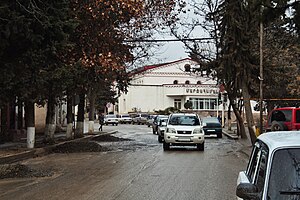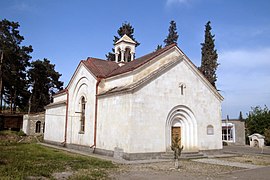|
Martuni, Nagorno-Karabakh
Martuni (Armenian: Մարտունի) or Khojavend[2] (Azerbaijani: Xocavənd ⓘ) is a town in Khojavend District of Azerbaijan, in the region of Nagorno-Karabakh. Until 2023 it was controlled by the breakaway Republic of Artsakh, as the centre of its Martuni Province, after the First Nagorno-Karabakh War. The village had an ethnic Armenian-majority population[3] until the exodus of the Armenian population of Nagorno-Karabakh following the 2023 Azerbaijani offensive in Nagorno-Karabakh.[4] EtymologyThe name Khojavend is of Persian origin.[5] The name Martuni originates from the nom de guerre of Armenian Bolshevik revolutionary and official Alexander Miasnikian. HistoryExcavations in the settlement have uncovered a number of tombs dating to the Neolithic and Bronze Age. The town is also home to several ruined medieval churches and remains of settlements, and khachkars have also been preserved.[6] The town was founded in the medieval period by local Armenians as a village named Khonashen (Armenian: Խոնաշեն), where shen means village and khona, depending on the source, allows different interpretations (namely, “village, dwelling” or “reservoir, well, spring”).[7] The old name of Khonashen originated from the nearby Khonashen river. Traditionally, the village belonged to the Melikdom of Varanda.[8] In 1925, the settlement was transformed into a city and renamed Martuni.[7] During the Soviet period, Martuni was the capital of the Martuni District in the Nagorno-Karabakh Autonomous Oblast. The population of the town, grouped into kolkhozes, largely occupied itself with raising livestock, grape growing, wheat cultivation, and gardening.[6] Nagorno-Karabakh conflictFirst Nagorno-Karabakh WarMartuni, and the district itself, became a frontline city during the latter stages of the First Nagorno-Karabakh War. In early February 1992, Vazgen Sargsyan, then Defence Minister of Armenia, appointed Monte Melkonian as Chief of Headquarters and assigned him to lead the defense of Martuni and the surrounding regions.[9] On October 2, 1992, Armenian armed forces captured the region around Martuni. According to an Azerbaijani source, considerable damage was done to the infrastructure of 10 villages settled by Azerbaijanis in the region during the war.[10] Melkonian remained as regional commander until he was killed in combat in June 1993.[11] 2020 Nagorno-Karabakh warFrom the very first days of the 2020 Nagorno-Karabakh war (started on 27 September 2020), Martuni was subjected to artillery shelling by the armed forces of Azerbaijan. This led to the disconnection of the city from electricity and gas supply. On 1 November, Azerbaijani aviation launched an airstrike on the city. The Armenian detachments managed to hold their positions in Martuni until a ceasefire was established. On 15 November 2020, a Russian peacekeeping contingent formed an observation post in the city.[12][13] On 13 February 2021, the specialists of the International Mine Action Center of the Ministry of Defense of the Russian Federation completed the clearance of the territory in the Martuni region.[14] On 1 March, a block-modular town was commissioned for the residence of military personnel of the Russian peacekeeping contingent.[15] 2023 Azerbaijani offensive in Nagorno-KarabakhFollowing the 2023 Azerbaijani offensive in Nagorno-Karabakh, the town came under control of Azerbaijani forces on 26 September 2023.[16] Azerbaijan's authorities reportedly dismantled a statue of Armenian militant Monte Melkonian.[17] Historical and cultural heritageThe town has a house of culture commonly called "The Opera", and the Church of St. Nerses the Great, opened in 2004. The Russian 19th-century Gevorgavan Church is located near Martuni.[18] Economy and cultureThe population mainly works in agriculture and animal husbandry. In 2015, the town had a municipal building, a house of culture, two schools, a music school, two kindergartens, a youth centre, 36 commercial enterprises, two factories and a regional hospital. The town also includes the villages of Kajavan and Kakavadzor.[19] Climate
DemographicsAccording to the census of 1933, 1028 people lived in the village, divided into 120 households, all of whom were Armenians.[20] The town has an ethnic Armenian-majority population, and also had an Armenian majority in 1989.[21] It had a population of 5,700 as of 2015.[1]
Gallery
References
External linksWikimedia Commons has media related to Xocavənd. |
|||||||||||||||||||||||||||||||||||||||||||||||||||||||||||||||||||||||||||||||||||||||||||||||||||||||||||||||||||||||||||||||||||||||||||||||||||||||||||||||||||||||||||||||||










